Related Research Articles
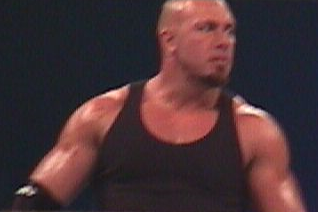
Barry Buchanan is an American professional wrestler. He is best known for his appearances with the World Wrestling Federation/Entertainment (WWF/E) under the ring names Recon, Bull Buchanan and B² and for his appearances with All Japan Pro Wrestling (AJPW) and Pro Wrestling Noah (NOAH) as Buchanan. Primarily a tag team wrestler, Buchanan is a former WWF World Tag Team Champion, All Asia Tag Team Champion, GHC Tag Team Champion and USWA World Tag Team Champion.
Mitsuharu Misawa was a Japanese amateur and professional wrestler and promoter. He is primarily known for his time in All Japan Pro Wrestling (AJPW), and also for forming the Pro Wrestling Noah promotion in 2000. In the early 1990s, Misawa gained fame alongside Toshiaki Kawada, Kenta Kobashi, and Akira Taue, who came to be nicknamed AJPW's "Four Pillars of Heaven", and whose matches developed the ōdō style of puroresu and received significant critical acclaim. Despite never working in the United States during the 1990s, Misawa had significant stylistic influence upon American independent wrestling, through the popularity of his work among tape-traders in the country. Misawa is regarded by some as the greatest professional wrestler of all time. However, the physical demands and consequences of the style in which he worked and the circumstances of his death have made his legacy, or at least that of ōdō, somewhat problematic.
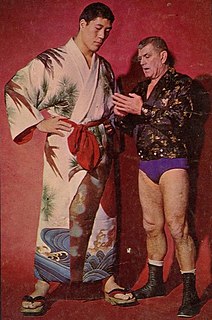
Shohei Baba, best known by his ring name Giant Baba, was a Japanese professional wrestler, promoter, and professional baseball player. He is best known as a co-founder of All Japan Pro Wrestling (AJPW), a promotion he founded in 1972 along with Mitsuo Momota and Yoshihiro Momota, the sons of his mentor Rikidōzan. For the first 10 years of its existence, Baba was the top star of All-Japan, while also serving as the booker, promoter, head trainer and president of the promotion from its inception in 1972 till his death in 1999. Baba was also responsible for recruiting much of the talent for All Japan, and was the public face of the promotion for much of his lifetime.

John Stanley Hansen II is an American retired professional wrestler.

The Triple Crown Heavyweight Championship is a professional wrestling world heavyweight championship in the Japanese All Japan Pro Wrestling promotion.
Yoshinari Ogawa is a Japanese professional wrestler who currently works for Pro Wrestling Noah. He has earned the nickname of "Rat Boy" due to his sneaky, clever in-ring tactics and baiting his opponents into quick pins.
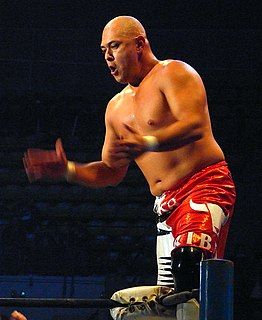
Maunakea Mossman is an American semi-retired professional wrestler, better known under his stage name Taiyō Kea (太陽ケア). He is the only wrestler to have held the Triple Crown Heavyweight Championship, the World Tag Team Championship and the World Junior Heavyweight Championship.

Naomichi Marufuji is a Japanese professional wrestler who competes for Pro Wrestling Noah, with occasional appearances in other professional wrestling promotions including New Japan Pro-Wrestling (NJPW), All Japan Pro Wrestling (AJPW), Ring of Honor (ROH), and Impact Wrestling. Marufuji is a four-time GHC Heavyweight Champion, as well as the first of two men to win Junior Heavyweight Championships in all three major Japanese promotions. In 2009, he was appointed to the position of Vice President of Pro Wrestling Noah, and has retained the position since, being reappointed in September 2011.

The World Tag Team Championship is a professional wrestling World tag team championship in Japanese promotion All Japan Pro Wrestling. It was created on June 10, 1988 as a unification of two previous tag team titles in All Japan; the PWF Tag Team Championship, and the NWA International Tag Team Championship; when the PWF champions Jumbo Tsuruta and Yoshiaki Yatsu defeated NWA champions The Road Warriors. As with the Triple Crown Heavyweight Championship, it is symbolized by four belts, two for each wrestler, representing the former PWF and NWA titles. It is currently the top of two tag team titles in AJPW, along with the secondary All Asia Tag Team Championship. There have been a total of 92 reigns shared between 60 different teams consisting of 65 distinctive champions. The current champions are Kono and Suwama who are in their first reign as a team.
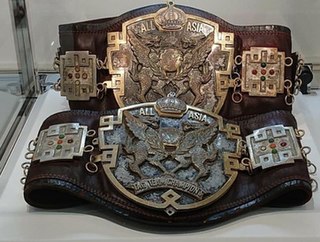
The (All) Asia Tag Team Championship is a professional wrestling tag team title in Japanese promotion All Japan Pro Wrestling (AJPW). It was created on November 16, 1955, in the Japan Wrestling Association (JWA) when King Kong Czaya and Tiger Joginder Singh defeated JWA founder Rikidōzan and Harold Sakata in a tournament final. Originally it was the top tag team title in the JWA, but its status became secondary once the NWA International Tag Team Championship was brought from the United States. It was abandoned in 1973 when the JWA closed, but was later revived in 1976 by AJPW in response to New Japan Pro-Wrestling (NJPW) announcing the creation of its own version of the title. It is currently one of two tag team titles in AJPW, along with the World Tag Team Championship. It is also the current oldest active title in Japan.

Masao Inoue is a Japanese professional wrestler who currently works for Pro Wrestling Noah as a freelancer. He started his career in All Japan Pro Wrestling in 1991, before jumping to Pro Wrestling Noah during a mass exodus in 2000. Inoue spent the next 12 years with Noah before returning to AJPW in 2012. Since then, he has competed regularly for both promotions as a freelancer.

The BJW Tag Team Championship is the top tag team title defended in the Japanese professional wrestling promotion Big Japan Pro Wrestling. The championship has been the leading tag team championship in the promotion since 1997. There have been a total of 57 reigns shared between 43 different teams consisting of 52 distinctive champions. The current champions are Okami who are in their third reign as a team.

Hirokazu Nagai, better known as Mitsuya Nagai, is a Japanese mixed martial artist, kickboxer and professional wrestler. He is known for his work in Fighting Network RINGS and later in pro wrestling companies like Battlarts and New Japan Pro-Wrestling (NJPW). He currently wrestles for Dradition Pro Wrestling (Dradition) and Pro Wrestling Noah (Noah).

Kensho Obayashi is a Japanese bodybuilder and professional wrestler better known by his ring name Zeus. He is currently signed to All Japan Pro Wrestling, where he is a former AJPW Triple Crown Heavyweight Champion and a former four-time World Tag Team Champion with Bodyguard.
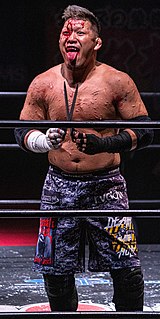
Masashi Takeda is a Japanese professional wrestler and mixed martial artist, primarily working for Big Japan Pro Wrestling (BJW) in the Deathmatch division. Takeda also competes as a freelancer for Freedoms and occasionally, All Japan Pro Wrestling (AJPW).
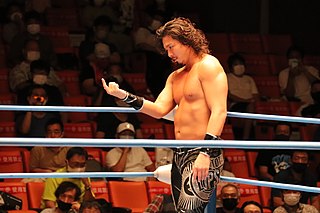
Lee Che-gyong, better known by his ring name Jake Lee, is a Zainichi-Korean professional wrestler, former mixed martial artist as well as former weightlifter trained by and currently signed to All Japan Pro Wrestling (AJPW).

Keisuke Ishii is a Japanese professional wrestler trained by and signed to DDT Pro-Wrestling (DDT). Ishii also competes for All Japan Pro Wrestling (AJPW), where he is a former World Junior Heavyweight Champion.

Hiroki Tanabe is a Japanese professional wrestler better known by his ring name Hi69. He is currently signed to Pro Wrestling Noah. Since debuting in 2000, Tanabe has frequently worked for Kaientai Dojo, Michinoku Pro Wrestling, Apache Pro Wrestling and Freedoms.

Wayne Pace, better known by his ring name Gianni Valletta, is a Maltese professional wrestler currently working for the Mexican promotion International Wrestling Revolution Group (IWRG).
Sueo Inoue, better known by the ring name Mighty Inoue, is a Japanese retired professional wrestler and referee. He is best known for his appearances with International Wrestling Enterprise from 1967 to 1981, with All Japan Pro-Wrestling from 1981 to 2000, and with Pro Wrestling Noah from 2000 to 2010.
References
- ↑ Kreikenbohm, Philip. "AJPW New Year Giant Series 2002 - Tag 1". Events. Cagematch.de. Archived from the original on 2011-07-18.
- ↑ Kreikenbohm, Philip. "AJPW New Year Giant Series 2002 - Tag 2". Events. Cagematch.de. Archived from the original on 2011-07-18.
- ↑ Kreikenbohm, Philip. "AJPW New Year Giant Series 2002 - Tag 3". Events. Cagematch.de. Archived from the original on 2011-07-18.
- ↑ Kreikenbohm, Philip. "AJPW New Year Giant Series 2002 - Tag 4". Events. Cagematch.de. Archived from the original on 2011-07-18.
- ↑ Kreikenbohm, Philip. "AJPW New Year Giant Series 2002 - Tag 5". Events. Cagematch.de. Archived from the original on 2011-07-18.
- ↑ Kreikenbohm, Philip. "AJPW New Year Giant Series 2002 - Tag 6". Events. Cagematch.de. Archived from the original on 2011-07-18.
- ↑ Kreikenbohm, Philip. "AJPW New Year Giant Series 2002 - Tag 7". Events. Cagematch.de. Archived from the original on 2011-07-18.
- ↑ Kreikenbohm, Philip. "AJPW New Year Giant Series 2002 - Tag 8". Events. Cagematch.de. Archived from the original on 2011-07-18.
- ↑ Kreikenbohm, Philip. "AJPW New Year Giant Series 2002 - Tag 9". Events. Cagematch.de. Archived from the original on 2011-07-18.
- 1 2 3 4 5 6 Kreikenbohm, Philip. "Giant Baba Cup". Events. Cagematch.de. Archived from the original on 2011-07-18.
- 1 2 3 4 5 "Giant Baba Cup". Misc. All Japan Events. ProWrestlingHistory.com.